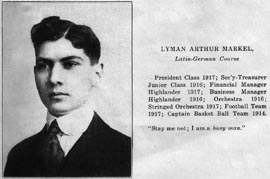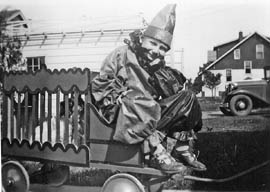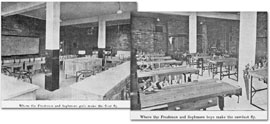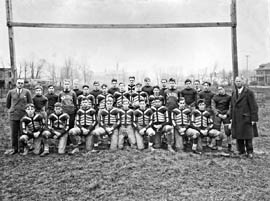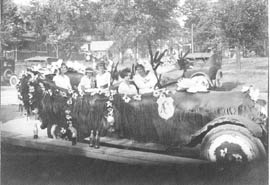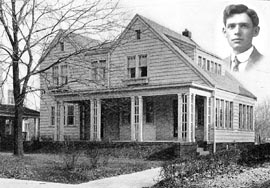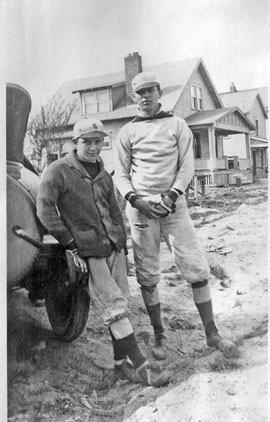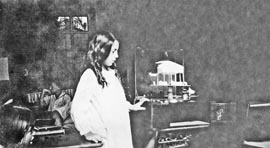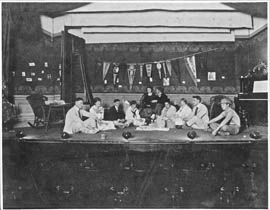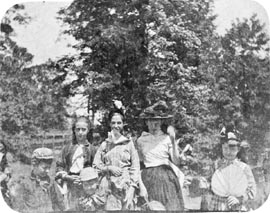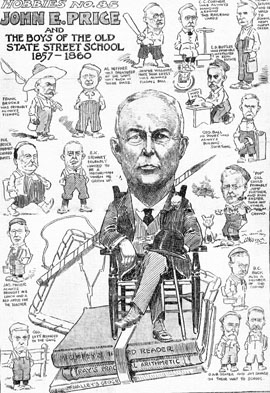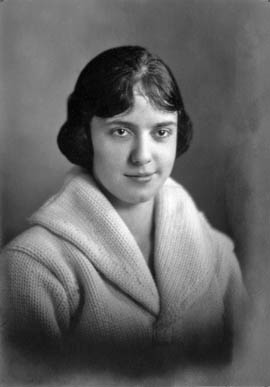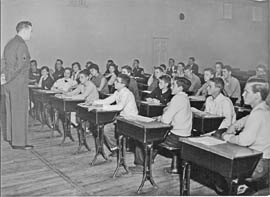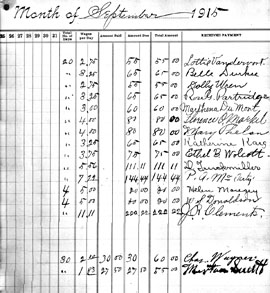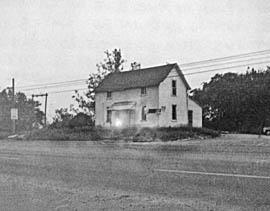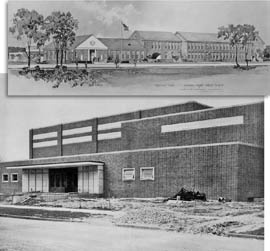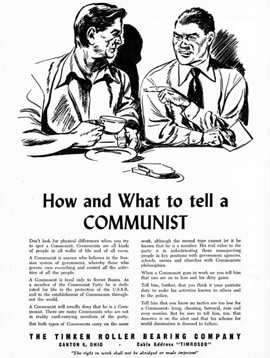| |
 |
| |
Whizzer Bicycle at
Grandview Cycle |
|
The Whizzer Motorbike Company began making motors that could be attached
to standard bicycles in 1939. Usually attached to Schwinn bicycles, these
kits included a two-horsepower flathead engine and associated drive accessories
that allowed speeds over 30 mph. In 1948 they developed a complete motorbike,
called the Whizzer Pacemaker (see ad at right). This photo shows the 1949
Pacemaker on display at Bob Hexter's Grandview Cycle. This $240 bike was
equipped with many of the custom add-ons available from Whizzer, including
the "studded" leather passenger seat, custom headlamp, rear kickstand,
and a 2.5 HP 4-cycle engine that got 125 mpg. The bike was started by opening
the exhaust and pedaling. |
|
| |
Lyman Markel |
|
Lyman Markel, president of the 1917 GHHS senior class, was referred to
affectionately as a “human dynamo” in his high school yearbook. Readers
were advised to essentially get out of his way because he was a “busy man”.
Even at an early age Lyman was adept at striking deals and fund-raising.
As a teenage grocery clerk, he negotiated, on behalf of Reed’s Groceries,
to trade toiletries for hams with the troops stationed at camp Willis in
Upper Arlington during WWI. The yearbook citation also indicates that he
was both the financial and business manager for the yearbook. After receiving
his engineering degree from OSU Lyman continued to support his high school
alma mater. He helped fund, design, and build the Rooks fraternity’s new
clubhouse on Elmwood Avenue. In 1933 the engineering firm he was employed
by was contracted by the school board to demolish the outdated Harding
School. Lyman wrote in 1976 that he was put in charge of the project. It
cost $300 to raze the building; he found a snake bullwhip in the rafters
in the school basement during the demolition, a discovery that caused quite
a sensation despite the board of education's best efforts to downplay it |
|
| |
Black Mask Drama Honorary |
|
Grandview High School members of the 1925 Black Mask Honorary are pictured
on the entry steps of the high school. According to the Highlander year
book, the “Black Mask was an honor society organized at the high school
in 1921 for the purpose of serving as an inspiration for the production
of better plays and creating and developing individual talent in dramatics”.
A requirement for induction was that an individual had to have a speaking
part in at least one Dramatic Club Production. In 1921 there were eighty-three
Dramatic Club members and the twenty-three of them shown here were distinguished
by membership in the Black Mask. Three productions were staged that year:
“Adam and Eva”, “Once in a Blue Moon”, and the senior class play “The Whole
Town’s Talking”. |
|
| |
Circus wagon |
|
The circus and circus parade projects have played a part in the curriculum
at the elementary level in the Grandview city schools since 1928. In 1934,
Arthur Murdock, dressed as a clown, and his pet dog (in the circus wagon)
were part of a very elaborate study of circus animals and life that culminated
in a production under the “Big Top” given for the public. Arthur’s father
constructed the wagon and it was pulled by two students dressed as horses.
The photograph is from the collection of Marvyth Bonham, who served as
a teacher at Edison and R.L Stevenson for over 40 years. She donated her
extensive photographic record of school activities to the Grandview Heights/Marble
Cliff Historical Society in 1993. |
|
| |
Classrooms at Edison |
|
Grandview’s first high school classes were conducted in the Harding
School built on Fairview Avenue in 1896. There were only four classrooms
and no indoor plumbing facilities. After the construction of the Grandview
Elementary School (current east wing of Edison Intermediate Middle School)
in 1912 some high school classrooms were provided in the basement of
the elementary school. These photographs are from the 1917 high school
yearbook and show the freshman and sophomore household economics (left)
and the manual arts (right) classrooms. By 1920 the household economics
room also functioned as the district’s cafeteria. Students helped with
meal preparation and clean up, which by necessity was completed by noon
so that the space could be used for teaching. The indoor restrooms in
the new elementary school served the entire student body and also served
as locker rooms for the athletic teams. The current high school was built
in 1922 to alleviate overcrowding and provide more modern facilities. |
|
| |
1926 GHS football
team |
|
The Grandview High School football team from the 1926-27 school year
is shown on the north end of the football field. Notice the goal posts,
constructed of 4x4 posts bolted together, and the barn and outbuildings
behind the house that was formerly located on the field. The houses to
the right are some of the first along the Star Road (now North Star Road)
to the west of the field. The high school is barely visible through the
haze in the center of the photo. The coach of the team, C.V. Money is the
tall man with the mustache in the center of the back row. The older man
at the left is Zura Walter, the physics and chemistry teacher, and the
man at the right is Dr. J.O. Stout, MD. |
|
| |
1949 seniors at Rook
cabin |
|
Eight seniors from the Grandview Heights High School Class of 1949 relax
by the fire on the edge of the ravine behind the former Brotherhood of
the Rook cabin.. Built in 1860, the cabin was originally the farmhouse
of the Garrett Miller family and was located on their property between
Cardigan and Fifth near Cambridge Blvd. It was dismantled, each log was
tagged and the cabin was rebuilt in its original form on its new site on
Wyandotte Road just south of Bluff. It served as the clubhouse of the Rook's
fraternity from 1915 until 1920. The members and their fathers later built
a house on Elmwood on a lot donated by Grandview founding resident George
Urlin. |
|
| |
Indian Village |
|
The "Indian Village Study" pictured above was produced by Grandview
2nd graders during the 1928-1929 school year. It contains miniature tepees
and canoes and was displayed in what was then the small music room on the
second floor of the original east wing of the Edison Intermediate Middle
School building. This was the students' first experience with group projects
and the first year the school district collaborated with Dr. Laura Zirbes,
a pre-eminent professor in the College of Education at OSU. Laura Zirbes
was a national leader in elementary education and reading instruction.
She founded the elementary laboratory school at OSU and was a strong practitioner
and promoter of the Progressive education philosophy. |
|
| |
Nancy Skeele |
|
This photograph is from the GHMCHS Skeele collection and shows Nancy
Skeele at the wheel of a car elaborately draped with crepe paper and flower
garlands. Her passengers are not identified. The photograph is undated
but the hobble skirt shaped Coke bottles on the wall in the foreground
were used after 1917. The “M.C.” initials in the shield on the car door
suggest that they participated in the local Field Day parade representing
Marble Cliff. The Skeeles lived at 1492 Roxbury. Nancy’s son Bradley indicated
in his memoirs that prior to WWI cars were a luxury and their use was limited
to recreational driving partly because most of the roads were unpaved,
full of ruts, and impassable seas of mud when wet. Car purchases were big
news in the day. The April 15, 1906 Columbus Dispatch reported that local
resident Carl Hoster purchased a $9,000 Fiat and a 35 horsepower Pope-Toledo.
Samuel Prescott Bush, Eugene Gray, and Theodore Lindenberg followed suit
and also purchased Pope-Toledos. George Urlin, however, bought a Frayer-Miller
with a limousine body. Frayer-Millers were manufactured in Columbus. Mr.
Hoster’s $9,000 purchase 102 years ago amounts to $205,000 in 2008 dollars.
Interesting that he apparently was accustomed to purchasing his automobiles
two at a time! |
|
| |
Silbernagel
Residence |
|
The Grandview home pictured above no longer exists. It was located on
the east side of Ashland Avenue, south of first. It occupied the area that
is currently the main entrance and rear parking lot of the Grandview Heights
Public Library. The home was occupied by C. E. Silbernagel, his wife Evelyn,
and their three children. Silbernagel was a pioneer ear, nose, and throat
specialist in Columbus. He received his medical degree from the Starling
Medical College in Columbus and maintained offices at East State Street.
He was an active civic leader and was the first president of the Men’s
Bible Forum of First Community Church. He was also a member of the Grandview
Heights school board from 1922 to 1928 during a time of unparalleled growth
and construction in the district. During his tenure as board president
the school district actually ran out of money and had to close early. |
|
| |
Julius Keitz Campaign |
|
The City of Grandview Heights election campaigns of 1947 were described
in the October 22 Columbus Dispatch as, “ [one of] the wackiest political
campaigns in recent years”. For example, mayoral candidate Julius B. Keitz
circulated the above flyer. His platform included police, fire, health,
recreation and safety issues, but his main promise was to provide citizens
with the opportunity to wrap their garbage without any additional charge.
Sixty years ago, prior to the development of garbage disposals or trash
compactors, it was commonplace to wrap table scraps and other kitchen waste
in used newspapers before placing it in the trashcan. While convenient
for the homeowner this procedure required extra handling by sanitation
workers who had to unwrap the garbage. His appeal to local housewives worked
and he was elected mayor. He served one term from 1948-1952. |
|
| |
GHHS Baseball - 1922 |
|
When this photograph was taken in 1922 the GHHS baseball team was the
youngest sport in the district. What had been a rather lackluster beginning
changed with the arrival of Roy Ohnsman (left) a talented, strong, freshman
pitcher. His back up pitcher was senior Nor Simons (right) who also played
first base. By the time Ohnsman graduated, the GHS yearbook noted that
the team was winning a majority of their games. The photograph is from
the Alleyne Higgs Jones collection. The precise location of the photograph
is not known but clearly indicates that residential streets were heavily
rutted mud tracks. |
|
| |
Dr. Young Residence |
|
The home of Dr. J.B. Young, 1180 Ashland Ave. was featured in the “Women
and Society” section of the March 24, 1907 Ohio State Journal. The home
was built for Dr. Young, a Columbus dentist and his fiancé, Clara Stanley.
The house was built by Dr. Young’s father, a noted Columbus contractor,
who also built the Casparis castle on Arlington Ave. The Youngs were married
on March 22. Tragically, two days later Clara’s father, who had traveled
from Virginia for his daughter’s wedding, suffered a massive heart attack
and died in the kitchen of the house the same day it was featured in the
paper. |
|
| |
Merry-Go-Round |
|
This sixty year-old photograph shows Grandview Elementary School second
grade students operating a miniature merry-go-round they constructed in
the spring of 1928. The caption indicates that the base was constructed
of cardboard with animal crackers glued to the surface. The canopy was
construction paper mounted on drinking straws. The base was attached to
a sewing thread spool that was mounted on the center post of a record player.
The carousel rotated on the turntable in sync with the music. The student
operating the carousel is not identified. In this day of iPods most current
second grade students have little notion as to the use of phonographs,
78-rpm records, or turntables. |
|
| |
1916 Senior Class Play |
|
The photograph above, taken on May 11, 1916, shows the cast
from the first GHS senior class play, entitled "Case of Suspension".
The play was the first of two performed over two nights; "A Japanese
Flower" was presented on May 12. Both productions were staged in the
350-seat auditorium in the Grandview Elementary School (currently the
east wing of Edison Intermediate Middle School). Baccalaureate services
for the Seniors were conducted two days later on May 14, followed by
the unveiling of the Class Memorial on May 16. The actual commencement
exercises occurred on May 17. Because there were only seven graduates,
three underclassmen were needed to complete the cast for the senior play.
The descendants of P.A. McCarty, the first high school principal, donated
this photograph to the Historical Society. |
|
| |
Elliot Children |
|
This photograph, taken in Marble Cliff around 1900, shows the Elliot
family children. Their father John was a prominent butcher and elected
as one of the trustees during the 1901 incorporation of the Hamlet of Marble
Cliff. Our research indicates that the family initially lived in a farmhouse
that was the first structure on the property which is the current site
of the Our Lady of Victory Church. They subsequently moved to the northern
edge of the Hamlet near King Avenue. Their daughter Mary presented this
photograph to their neighbors, the Newhouses, who lived at 2020 West Third
Avenue. Mr. Newhouse was stationmaster at Marble Cliff Station, which was
located at the base of the hill at Fifth Avenue and Dublin Pike (Dublin
Road). |
|
| |
Salzgaber Harvest |
|
This photograph (taken in 1912) shows Clarence and Harry Salzgaber with
newly harvested baskets of sweet corn. The Salzgaber family operated a
truck farm and greenhouses in Grandview Heights on the east side of what
is now Grandview Avenue. The family farmhouse still stands on the northeast
corner of Grandview and First Avenue and is currently home to the Tri-Village
photography studio. The Salzgabers provided vegetables for the stands at
the Columbus Central Market and the North Market. When their Grandview
acreage was sold for development in 1916 the family moved operations to
Lane Avenue across from what is now the Lane Avenue Shopping Center. This
photo and other Salzgaber memorabilia were donated to the Historical Society
by Betty Salzgaber. |
|
| |
John Price Classmates |
|
Beginning in 1902 Marble Cliff entrepreneur and real estate developer
John E. Price began hosting annual reunions of his “upper-crust” grammar
school classmates, all of whom attended the State Street Grammar School
in downtown Columbus from 1857 to 1860. He owned the Marble Cliff Quarries
and together with other family members platted the original development
of Marble Cliff in 1889. Formal invitations were mailed, and a special
streetcar brought the alumni to the Price mansion on the hill on the southeast
side of the intersection of Fifth Avenue and the railroad tracks. The party
then moved to the Arlington Country Club for dinner. The caricature above
was from one such alumni gathering. “Princey Price” is pictured in the
center. Other Columbus notables include L.D. Buttles, E. K. Stewart, James
Miller, and numerous business titans of the period. John E. Price hosted
the yearly gatherings until his death in 1914. His obituary mentioned he
was the chief promoter of these alumni gatherings and indicated that the
tradition would continue in his memory. |
|
| |
Alleyne Higgs |
|
Alleyne Higgs (shown here in her graduation photo) and her family moved
to their family home at 1219 Lincoln Road in Grandview Heights in 1906.
She graduated from GHS in 1922 and married popular Grandview coach and
principal Stanton Jones. Like many girls of the time, Alleyne gathered
personal memorabilia in scrapbooks, beginning her collection in 1918 and
ending only with her death in the 1980’s. Her collection was donated to
the Historical Society in 2005 and constitutes the largest acquisition
received to date by the Society. It consists of over 1,000 individual items,
including over 200 obituaries of early Grandview residents, 500 newspaper
clippings, and 200 original photographs, as well as graduation programs,
play bills from high school plays, hand bills announcing sporting events,
and assorted party favors and invitations. She was a charter member of
the GHMCHS and was active during its formative years. The society is indebted
to her and her family for their generous contribution. |
|
| |
GHS Study Hall |
|
This undated photograph is from a recently acquired collection of memorabilia
from the GHHS office. From the style of clothing it appears to date from
the 1950s. It shows students listening intently to military recruiters
in the large study hall originally present on the second floor of the high
school. An army sergeant is addressing the students while a marine recruiter
and an Air Force Staff Sergeant sit in the background. Recruitment speakers
are still part of the GHHS experience. During this era the study hall was
a mainstay of the high school schedule, and was a hub of activity both
during and after school (for example, it was decorated for homecoming and
football games.) Student “study hall checkers” monitored attendance. Scheduling
of study halls has declined due to the current emphasis on students enhancing
their college applications with more rigorous academic schedules and extracurricular
activities. This large high school study hall has since been partitioned
into several classrooms. |
|
| |
GHS Payroll Ledger |
|
This ninety-three-year-old page from a Grandview Heights City School
District payroll ledger documents the hours and wages for the employees
for the month of September, 1915. Fourteen faculty members were employed
and their daily pay ranged from $2.75 per day for elementary teachers (Lottie
Vanderwort and Dolly Wren) to $11.11 per day for J.R. Clements, who was
the district superintendent. P. A. McCarty, the high school principal,
earned $7.22 per day. A separate scale for custodians indicates that Mr.
Wagner made only seventy-five cents less than the lowest paid faculty member.
When adjusted for inflation the $2.75 earned in 1915 is equal to $56 in
2008. |
|
| |
Masters-Tucker house |
|
GHMCHS member and photography enthusiast, Galen Gonser took this photo
on May 22, 1970. His caption indicates that is shows the Masters-Tucker
house that stood on the west side of Dublin Road just south of the Dublin
Road and Fifth Avenue intersection. It was a residence and subsequently
an antique shop. The site is currently occupied by a Certified gas station.
Galen indicates that he took the photo with an 1892 Kodak #2 Falcon Box
camera, and a light leak in the old camera caused the bright spot in the
center. The Historical Society welcomes an opportunity to scan, archive
and publish any historical photographs that our readers might have access
to. Please contact the GHMCHS at tdemaria@columbus.rr.com |
|
| |
GHHS Gymnasium Addition |
|
Grandview Heights built the current high school in 1923, and the original
building had the gymnasium on the first floor off the main corridor (where
the current auditorium is located.) In 1945 an addition was proposed (top
photo) that would house a memorial to the Grandview High School students
who gave their life in World War II (shown in the rendering by Benham and
Richards Architects at the top. The drawing appears to have a gymnasium
located behind the memorial structure.) The bottom photo from 1957 shows
the final construction stages of the current gymnasium located at the south
end of the school. The architectural drawing is from a collection of materials
that was recently recovered from a storage space in the high school. |
|
| |
Timken yearbook ad |
|
The Timken Roller Bearing Co. was founded as a carriage works in St.
Louis in 1899 by Henry Timken, onetime blacksmith. In 1902 he moved the
company to Canton to be closer to the automotive industry, and opened the
Columbus Bearing Plant on East Fifth in 1920. The company supported local
schools, advertising in Grandview's yearbook with full page ads from 1951
to 1958. These ads reflected the patriotic nature of the Timken company,
focusing mostly on bringing the "responsibility of voting" message
to high school students. The ads also reflected the cold war fears of the
time, as depicted in this 1951 ad. |
|

